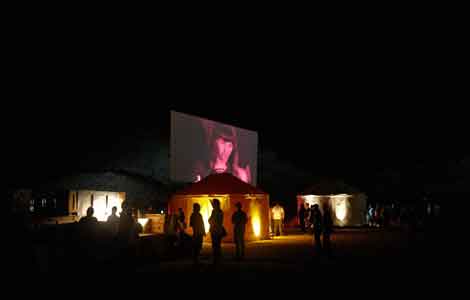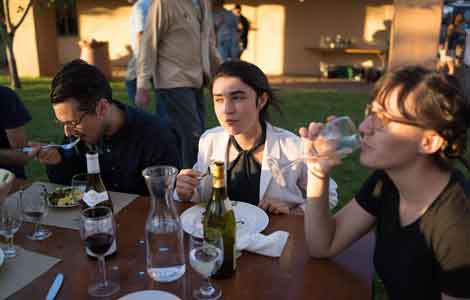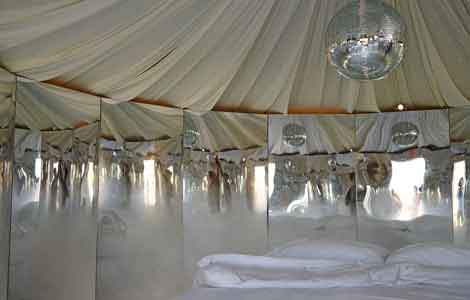The traveling art bash “Station to Station” concluded its nationwide tour in Oakland last week and it just goes to show: There’s nothing like a road trip fueled by a cool million in corporate donations for having a good time.
Ask anyone on board for the coast-to-coast rail fest and they’ll tell you what an “amazing” trip it was.
Beyond that you’d be hard pressed to say just what was accomplished by Los Angeles artist Doug Aitken’s extravagant expedition. There was music, but nothing to rival the average output of Clear Channel or Goldenvoice, or any other mainstream concert or club promoters. The professionals do a better job with tickets, security and promotion—it turns out experience counts for something after all.
And there may have been art—that judgment is reserved to the beholder—but nothing that will survive the end of the tour, unless road-trip slide shows are your cup of chai.

Urs Fischer’s, Kenneth Anger’s and Ernesto Neto’s nomadic, photo Alayna Van Dervort courtesy of LUMA Foundation sculptures in Barstow
Artillery caught up with the roadshow in Barstow, on the high harsh edge of the Mojave, the last stop before Los Angeles. The town’s main strip is the old Route 66, with its parade of fading dive stucco motels featuring cactus themes and postage-stamp pools. Take a right off main street and in half a mile you’ll find the Skyline Drive-in theater, a mainstay since the ’60s. This is where the Aitken’s posse staged its “happening,” a gift to the Barstow residents.
Never lacking ambition, tour promoters propose to make Barstow “the most interesting place in the country,” if only for the night. The whole venture was, apparently, a mission of mercy, bringing the blessings of grant-funded art to unwashed masses from Brooklyn to San Francisco, and at eight lucky waystations in between.
We arrived early and found parking quickly; it felt sparsely attended as dusk turned to night. There was a concession stand serving popcorn and soft drinks, just like a real drive-in. Over to the right were food trucks and scattered further out were several round tents set up yurt-style for art installations. Urs Fisher did a disco-style tent, complete with dry-ice smoke and disco ball. There was a Kenneth Anger video dome, and a pink squishy Ernesto Neto “sculpture” that felt like a Bedouin makeout cabana. These tents constituted the principal art presentations for what purported to be a public art event. They were underwhelming, to say the least. You couldn’t help but wonder, is that all there is?
There was more of course. Close by the yurts, LA scenesters No Age knelt before one of the two movie screens and strummed dissonant chords beneath images shot by photographer Stephen Shore. He’s famous for capturing the banalities of American life—easy pickin’s in desolate Winslow, Arizona—his subject for this slide show. Colored flags by Sam Falls hung from a chain-link fence comprised another installation. And nearby was a pile of the shipping crates hung with posters from previous tour stops. The desultory assemblage posed the question again: Is that all there is?
There were some excellent videos projected on the big screen: underground classics by art-film gods like Bruce Conner—kids today don’t know them, so I suppose that was the purpose of featuring them. Or perhaps the organizers wanted to show they were cool and knew their art videos. But without context it all felt very disjointed, like MTV but without any link between the music and the images.

The Bruce Conner video projection, part of the moving image, photo Alayna Van Dervort courtesy of LUMA Foundation
After scoping out where to buy a drink (only lite beer? what’s up with that?) it starts to become clear: however fabulous these people are as artists, they are not very good at running a show. They immediately ran out of the only non-lite beer (Corona!). There was never an emcee. Nobody knew whose art was whose. Nobody ever announced who was performing at the time. There were programs, but apparently they were an afterthought—somebody wandered through the crowd passing out a printed lineup sheet. It was reported later that nobody told anyone in Barstow about the happening on the edge of town. And where was the almighty Doug Aitken?
Part of the problem may have been the setting. The high sky and far horizons of the Mojave would dwarf any event thrown by puny humans—even artists with unlimited technology at their disposal.
The show felt more coherent two nights later, in Los Angeles, although the “nomadic sculptures,” as they called the art tents, were just as lame in the Union Station patio as on the tarmac in Barstow. And Beck put on a descent show at both venues—more a tribal stomp than his usual edgy ensemble arrangements—but it’s hard to credit that to the folks on the train. (I should add, the crowd at Barstow was much more sedate; my companion kept getting dirty looks everytime she yelped a whew-hoo!)
But it was hard to get past the impression that Aitken and his merry band had failed to accomplish much more than convince the people at Levis to underwrite a month-long fantasy road trip for the truly hip. They traveled, according to the Station to Station website, in “ease and elegance.” The principal hangout was the “Super Dome,” a second-story observation car, glass all ’round, decked out with customized furniture decorated by Jorge Pardo. All that suffering-for-art business was banished, the clever creatives enjoying “daily organic meals” prepared by a “chef and forager,” and whiling away the hours noodling around on “incredible equipment” donated by Moog, Neve Designs and SE Electronics
Come to think of it, that may be one of the real proficiency demonstrated by Aitken and his staff. Somehow they managed to convince Levi’s, Moog, and a half dozen other “partners” to hand over more than a million dollars to make that party happen. Grantors dot the website like a case of the mumps—Levi’s, of course, and the Art Production Fund; the Open Arts Project, from the UK, and the LUMA Foundation, from France, all sold on the idea that Aitken would help elevate the masses just by rolling through town.
Unfortunately, the website also shows another area in which the artists-en-training proved deficient. They were very good at raising money for themselves, but when it comes to fundraising, they were pretty much a bust. One of the goals of the trip was to raise funds for the “Station to Station Cultural Fund,” which proposes to finance “artists of all disciplines to produce significant new work that advances public understanding of creative expression and introduces new definitions of art and culture to a global audience.”

LIVING LARGE: From left, artist Felix Melia, photographer Mara McKevitt, Audrey Snyder digging into their cactus omelets in Winslow. Photo Leif Hedendal
Ambitious as ever… and just as overblown as the rest of the project. Working with the smug slogan “If you don’t give back no one will like you,” the Station to Station fundraisers have tallied a total of $19,410. Not much bang for a million-plus bucks in startup funds.
Jeffrey Deitch, outgoing MOCA director and longtime Aitken supporter, recently told the New York Times, “Doug is one of the people defining what art can do right now.” It also appears, with Station to Station, that Aitken has touched on the boundaries of what art can’t do. Best, perhaps, to stick to the studio and leave American culture to find its way on its own.
All images courtesy: Station to Station is an artist-driven public art project made possible by the Levi’s® brand. ©Station to Station, Doug Aitken, 2013






